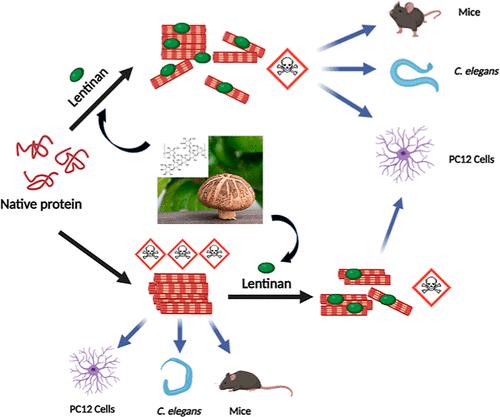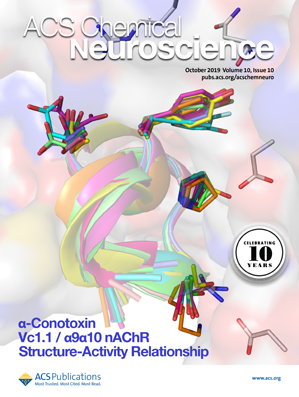Bifunctional Inhibitor Lentinan Inhibits Fibrillogenesis of Amyloid-β Protein and α-Synuclein and Alleviates Their Cytotoxicity: In Vitro and In Vivo Studies
IF 4.1
3区 医学
Q2 BIOCHEMISTRY & MOLECULAR BIOLOGY
引用次数: 0
Abstract
Alzheimer’s disease (AD) and Parkinson’s disease (PD) are the two most common neurodegenerative diseases in the world. Misfolding of β-amyloid (Aβ) and α-synuclein (α-syn) and subsequent fibril formation are closely associated with the pathogenesis of AD and PD, respectively. Lentinan is a natural product commonly used in medicine and dietary supplements. It has potential antitumor, anti-inflammatory, and antiviral effects, but the underlying mechanism of its action on AD and PD remains unclear. In this study, lentinan inhibited the formation of Aβ and α-syn fibers in a dose-dependent manner and disrupted their mature fibers. Lentinan inhibited the conversion of Aβ and α-syn conformations to β-sheet-rich conformations. Additionally, lentinan protected Caenorhabditis elegans against damage caused by the accumulation of Aβ and α-syn aggregation and prolonged their lifespan. Notably, the beneficial effects of lentinan in AD and PD mice were also demonstrated, including ameliorating the cognitive and memory impairments in AD mice and behavioral deficits in PD mice. Finally, molecular interactions between lentinan and Aβ/α-syn pentamers were also explored using molecular docking.

双功能抑制剂 Lentinan 可抑制淀粉样β蛋白和α-突触核蛋白的纤丝化并减轻其细胞毒性:体外和体内研究
阿尔茨海默病(AD)和帕金森病(PD)是世界上最常见的两种神经退行性疾病。β-淀粉样蛋白(Aβ)和α-突触核蛋白(α-syn)的错误折叠以及随后的纤维形成分别与阿尔茨海默病和帕金森病的发病机制密切相关。龙胆素是一种常用于医药和膳食补充剂的天然产品。它具有潜在的抗肿瘤、抗炎和抗病毒作用,但其对AD和PD的作用机制仍不清楚。在这项研究中,龙胆南以剂量依赖的方式抑制了Aβ和α-syn纤维的形成,并破坏了它们的成熟纤维。龙胆南抑制了 Aβ 和 α-syn 构象向富含β片的构象的转化。此外,龙胆南还能保护秀丽隐杆线虫免受Aβ和α-syn聚集造成的损害,并延长其寿命。值得注意的是,研究还证实了扁豆南对AD和PD小鼠的有益作用,包括改善AD小鼠的认知和记忆障碍以及PD小鼠的行为缺陷。最后,研究人员还利用分子对接技术探讨了龙胆南与Aβ/α-syn五聚体之间的分子相互作用。
本文章由计算机程序翻译,如有差异,请以英文原文为准。
求助全文
约1分钟内获得全文
求助全文
来源期刊

ACS Chemical Neuroscience
BIOCHEMISTRY & MOLECULAR BIOLOGY-CHEMISTRY, MEDICINAL
CiteScore
9.20
自引率
4.00%
发文量
323
审稿时长
1 months
期刊介绍:
ACS Chemical Neuroscience publishes high-quality research articles and reviews that showcase chemical, quantitative biological, biophysical and bioengineering approaches to the understanding of the nervous system and to the development of new treatments for neurological disorders. Research in the journal focuses on aspects of chemical neurobiology and bio-neurochemistry such as the following:
Neurotransmitters and receptors
Neuropharmaceuticals and therapeutics
Neural development—Plasticity, and degeneration
Chemical, physical, and computational methods in neuroscience
Neuronal diseases—basis, detection, and treatment
Mechanism of aging, learning, memory and behavior
Pain and sensory processing
Neurotoxins
Neuroscience-inspired bioengineering
Development of methods in chemical neurobiology
Neuroimaging agents and technologies
Animal models for central nervous system diseases
Behavioral research
 求助内容:
求助内容: 应助结果提醒方式:
应助结果提醒方式:


